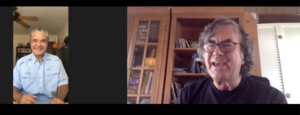
So it was the Summer Olympics of 1996 in Atlanta, GA. My wife and I were down there as guests of CNN and Time Inc. (I think). It’s hard to remember cause back around then print and “traditional” media was still flying high and it would be a couple of years before the “world wide web” would clip their wings. Being in a decision making capacity from a major advertiser meant you got to go to a lot of neat places where you spent your company’s money. Ahh the good old days!
Anyway, during the day the media hosts would shuttle you from event to event and lead you with their little signs like school kids on tour. It was cool because you got to go in ahead of all the folks that paid for their own ticket. Then at night they would host a fabulous dinner at a fabulous restaurant and you would be surrounded by fabulous people. Often, they would have a prominent guest join your table, which of course introduced a whole other level of anxiety.
One evening, our prominent guest was the Reverend Jesse Jackson. We all had our circles within circles over cocktails and I noticed several of the media big wigs commanding his attention. Being one who likes to look more than listen, I had a hard time focusing on the blabber in my circle and instead kept looking over at the Jackson Circle. They had a very predictable and professional conversation underway with backs stiff, cocktails held firmly, and an occasional audible “ahaha!”
Before we sat down I saw him excuse himself and go down the corridor and go behind partitions that were there to separate us from the food prep. I wondered what was going on in there? Who is he meeting with? What are they doing? So I feigned a men’s room break and walked over and peeked in. I thought maybe I would get a glimpse of some other big power figures he needed to chat with secretly or something. Or maybe it was his escape hatch from us.
What I witnessed I’ll never forget. He walked in and greeted all the cooks and the servers. At first they were shocked and held in disbelief. Then every face lit up as they realized who was in the room and that he made a point to come in and speak with them! Keep in mind it was a high pressure moment with lots of food being prepared and about to be served. But then there was more. He asked them to all bow their heads in prayer and he asked for God’s blessing on them. And just like that it was over – time to get back to work.
I walked back to my table where the blabbering was still going strong, providing a certain din that is common in events like this. Reverend Jackson came back, and then the servers all came out in military precision serving one of the finest meals ever. No one else in the room knew what just went down.
My wife sat near Rev. Jackson and at the time she served on our board of education. Soon thereafter Jesse Jackson’s Rainbow Coalition came and marched though our town center. My wife joined him in that march and I’m proud of her for it. I don’t remember where I was that day – too busy I guess.
But, getting back to what I saw behind that partition. It really sunk in much later that I was the only one from that corporate group that got to see Jesse Jackson pray and bless the folks that were “behind the partition.” There were no cameras there. No reporters. No selfies. No sound bites. No memes produced. No social postings. Nothing was posed or planned. It was a genuine moment that impacted the life of every person in that back room. And me, whose need to be nosey for once paid off.
I can’t remember any of the events that we saw, and I can’t remember any of the conversations from the cocktail blabber. But I think about the people and the prayer I witnessed quite often and how it asked me to listen better with my eyes, and see better with my ears.
#BeVital #Marketing #Covid #KFC
You can’t open your LinkedIn without seeing a company expressing its thoughts, regrets, suggestions, and commitments regarding racial equity. While this is encouraging and perhaps long overdue, I’m not convinced that the message has really penetrated, nor that the solutions will get at the heart of the matter.
In fact, many of the commitments sound like they are the same thing over and over again:
- better minority representation on our boards
- better minority representation in our executive ranks
- better training for our employees who MUST be harboring hidden biases and are the ones truly at the root of all our problems.
Of course, I editorialized a bit on that last point, but having been on both the delivery and the receiving end of such training in the corporate world, that is how a lot of the employees will be made to feel.
Meanwhile, the best companies continue to recruit from the best schools, and want their best students who are also “people of color.” Basically, regardless of color, people of means. People who have more in common culturally and philosophically than their skin color or appearance might suggest.
But what about the treasure box you already have in your own back yard? Your own employees that are on the front line of customer service! Several years ago I was the corporate CMO of a major Fortune 500 health benefits company. At the time we had extensive diversity training underway and very active recruitment programs for minority candidates. Many coming from the MBA factories of the Ivy Leagues.
Meanwhile, the toughest job in our company were the people that had to “man” the customer service lines for our health benefits. Not only was it among the toughest jobs it was also among the lowest paid. We had some customer service issues so I decided to conduct some focus groups that got to the motivations of the people that did these jobs.
“See That Man Up There?… We Don’t Listen To Him!”, she giggled.
It should come as no surprise that our US based service centers were staffed with a high degree of minority employees, mostly African-American, and Latino, and many being single mothers. I went into it thinking that they do this job because they have few other options. I was wrong. When asked what motivated them for such a tough (low paying) job the answers were as follows:
- I like helping people
- A lot of people calling us are old people, they’re lonely, they want someone to talk to
- I feel needed here and it is a break from some of the issues I have to deal with at home
That last issue mentioned above was related to life back in a tough urban environment for many of them. I especially got a kick out of them when they pointed to their frowning manager looking down from the balcony at us because he had to account for their time away from the phone. One of the respondents giggled and said, “Do you see that guy up there? That’s our manager. He wants us off the phone within 90 seconds. We just ignore him. Most of the people who call want to talk or they need more than 90 seconds.”
I flew home that evening being blown away by those young ladies. I realized that even though I headed marketing for this company, those young ladies knew more about our customers and our products than me. And for that matter virtually every member of the executive suite and every employee that doesn’t directly touch our customers. I thought, we shouldn’t be training them, they should be training all of us!
Why Do We Value Theory Backed By Case History Convulsions So Much?
Then I thought, why are we spending so much money on recruiting candidates from expensive schools that come to us with theory, backed by case history convulsions, with absolutely no real experience with our products or customers?
So our team recommended that if we were truly serious about dealing with racial equity within our company, we should mentor a percent of the folks that are working the customer service centers into an upward growth path. Oh, and pay them better. Now of course this goes beyond diversity, but given the make up of the people that were in those centers, it certainly would help address diversity.
I thought that recommendation was so obvious that it hurt. That it was something sitting right in front of us waiting to be grabbed. It not only would help address the racial divide but the economic divide as well. But for some strange reason, that recommendation fell on deaf ears. For some reason, it made people uncomfortable in ways that they wouldn’t or couldn’t express. And that reaction was also shared by the folks running the diversity programs. Oh and by the way, I didn’t push hard enough, I gave up way too quick!
Time To Reap What’s In Our Gardens?
So, perhaps as we struggle with the issue of racial equity, we consider programs like that. Perhaps we look within our own operations… in our own gardens. The folks in the service centers. The folks on the warehouse floor. The folks in delivery services. These are the folks that really know the product. They are the ones who really know the customers. These are the folks that really know all the different relationships in the value chain. These are the folks that can help make the company a better company and also help it be a more accurate reflection of society. And it doesn’t have to cost you $100 million. You won’t have to hire an ad agency to express how sorry you are and how you will be different. It will be a way to show that your are committed to true action in an arena that is credible for you – your own back yard.
I don’t mean to be simplistic and make it sound that there are such simple solutions to complex problems. Indeed every idea which sounds simple is full of complexities. But it is a start and it is something that can be done within the frameworks that we ourselves control.
There is nothing to lose here and much to gain.













